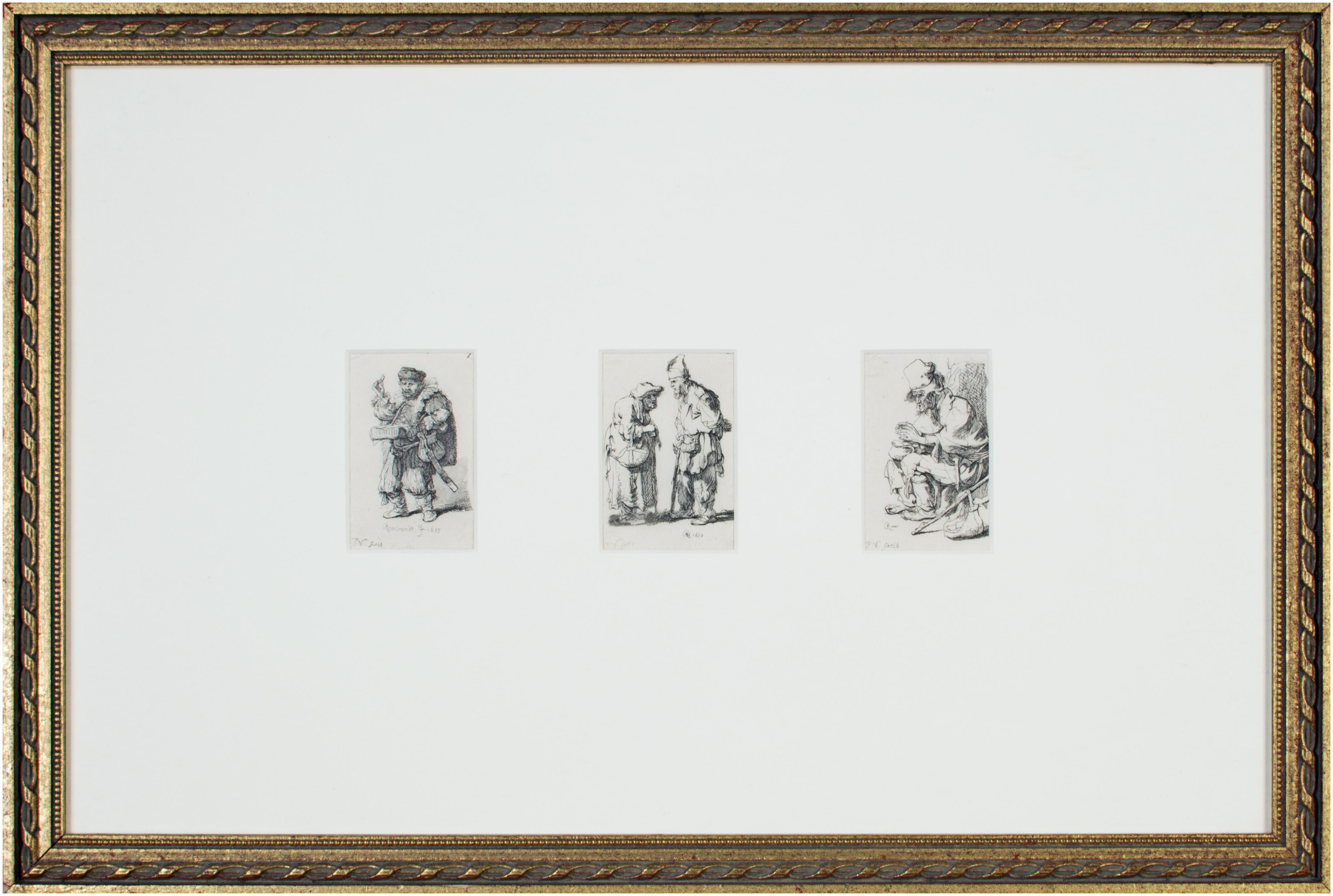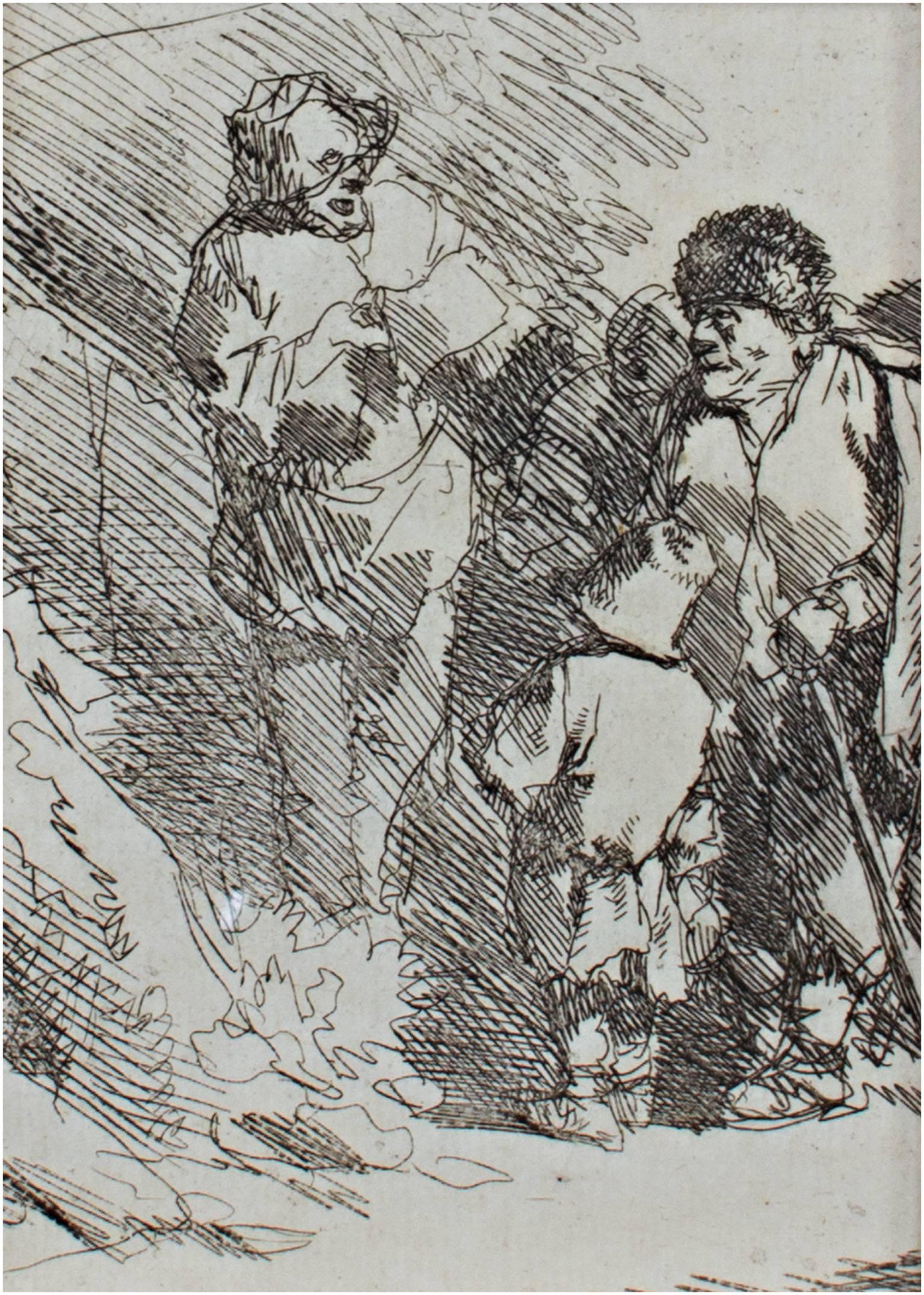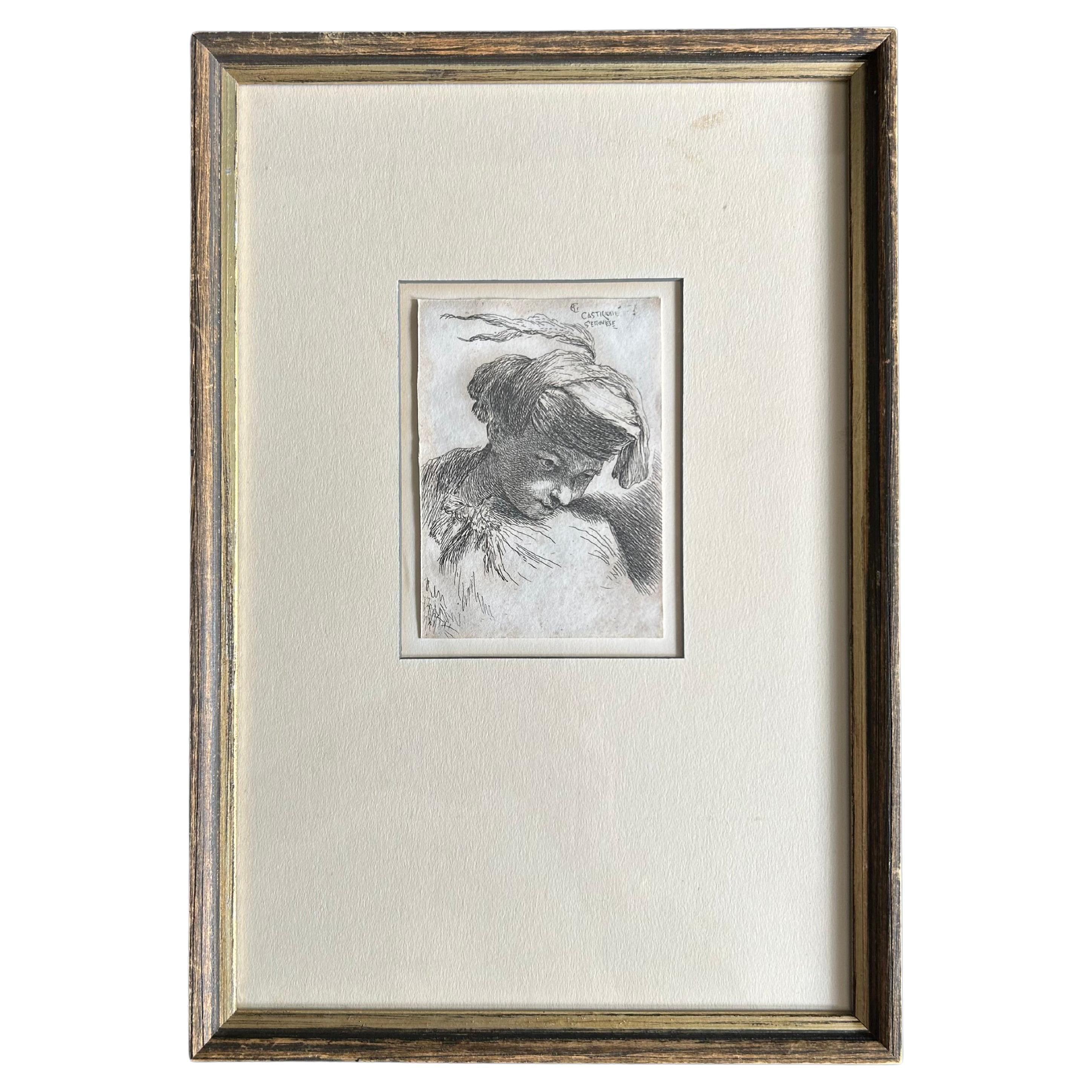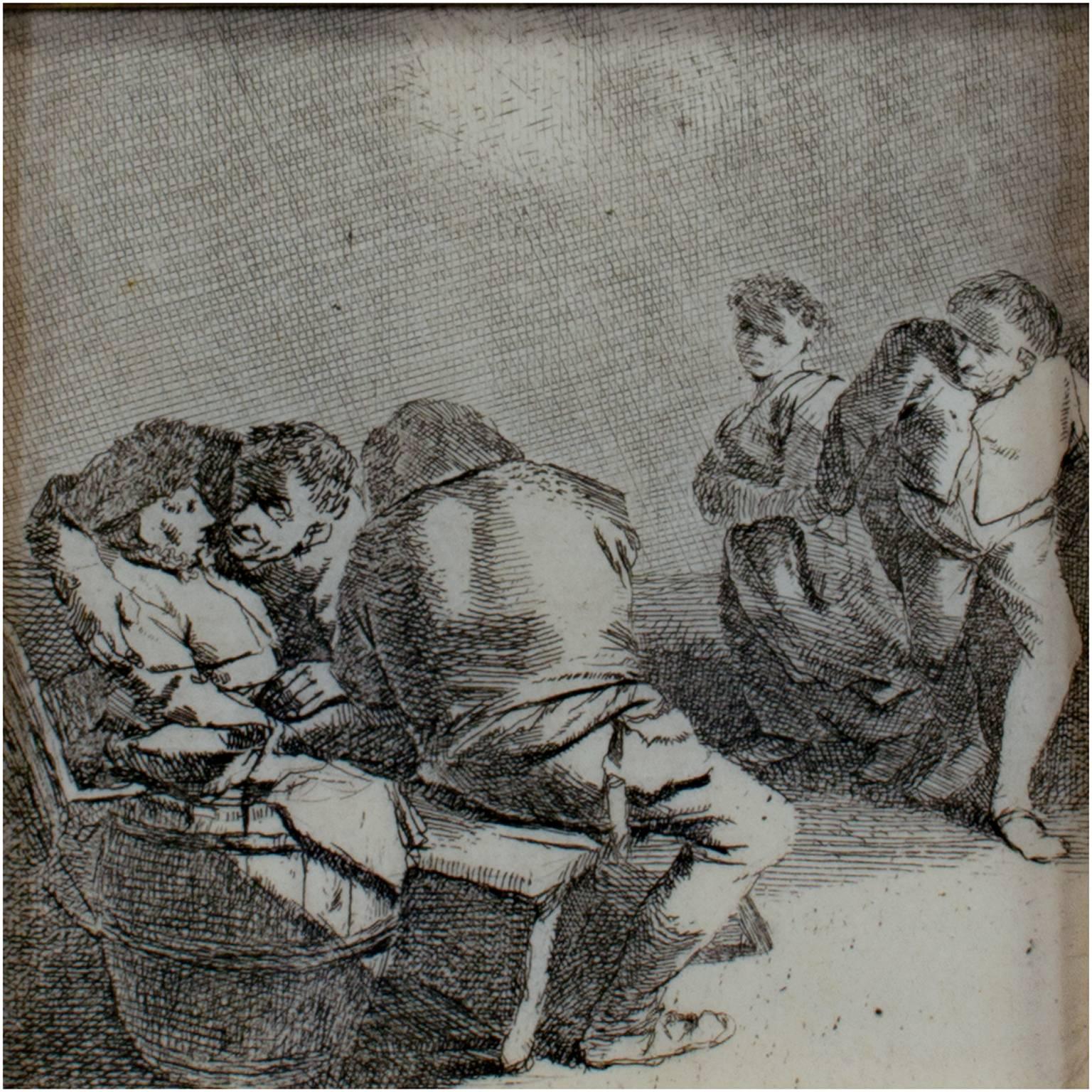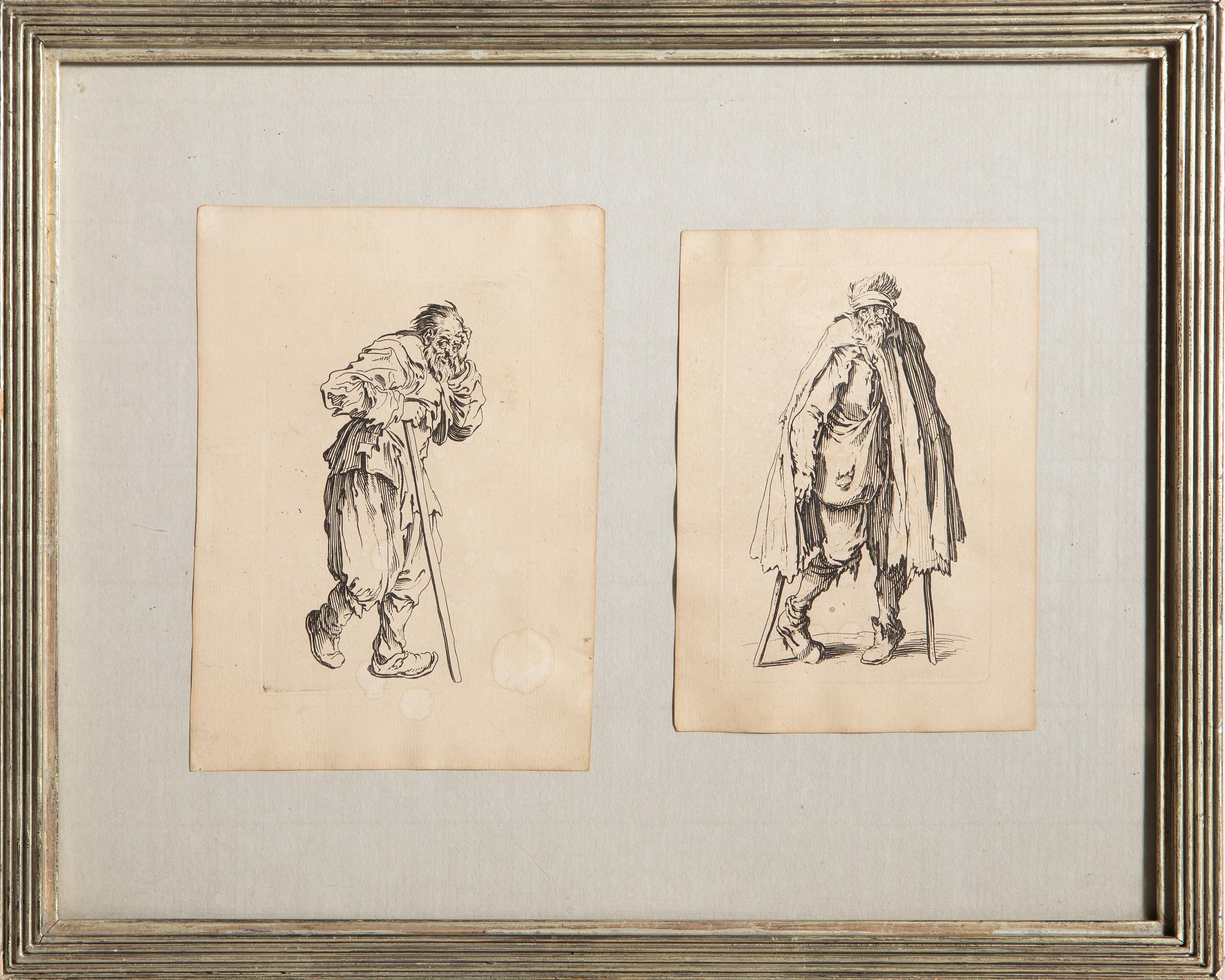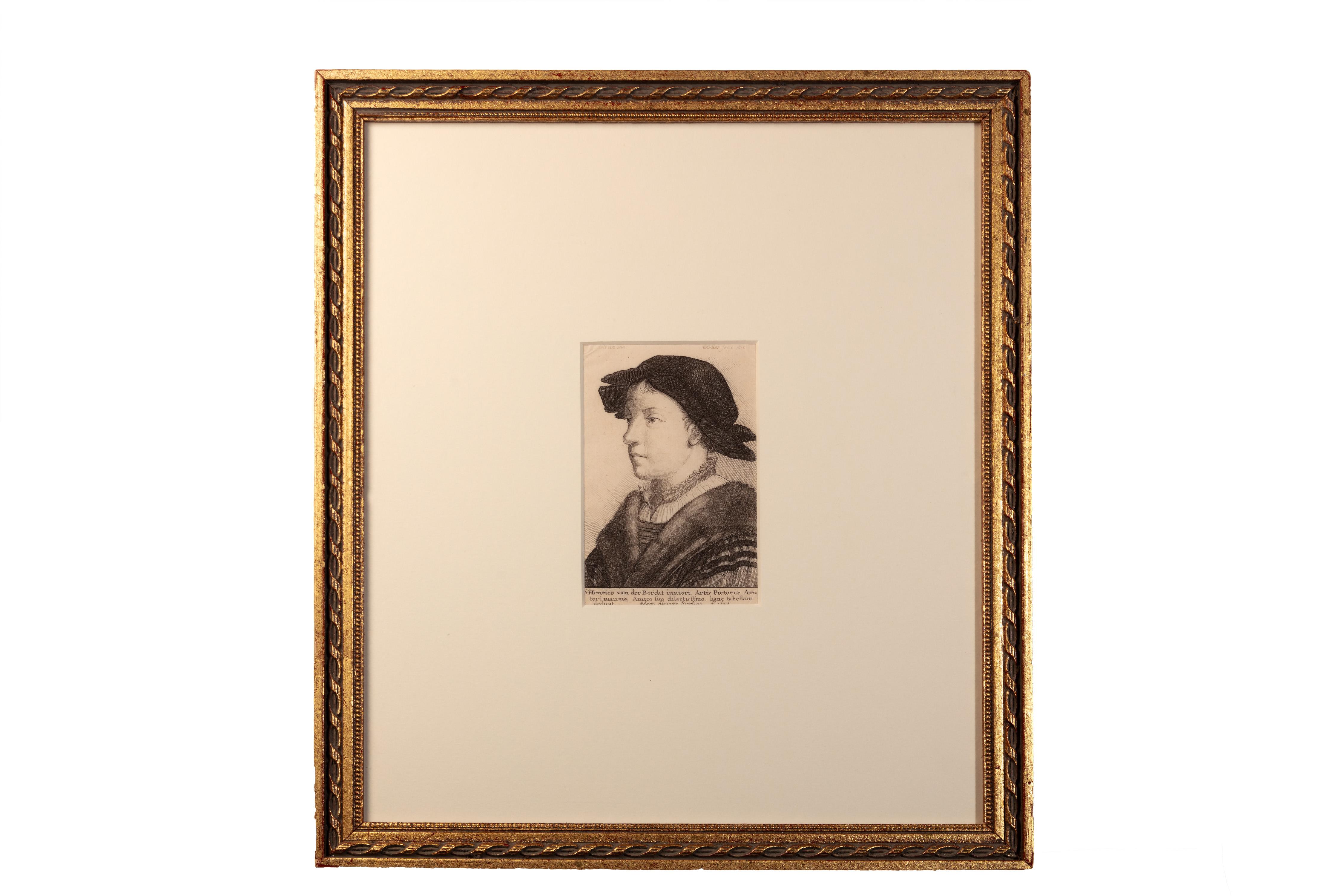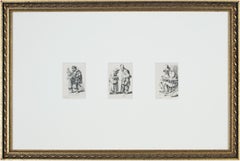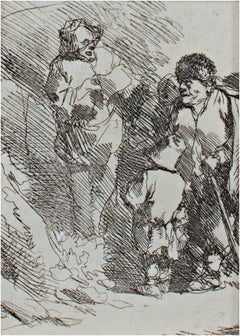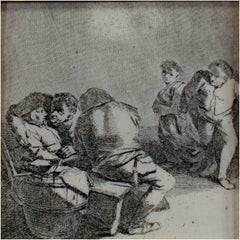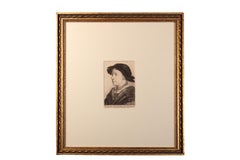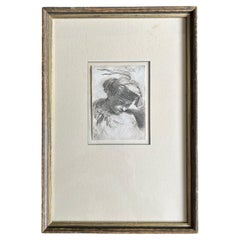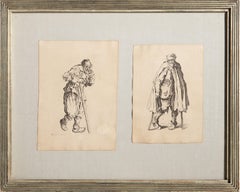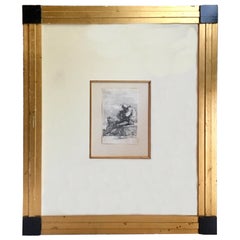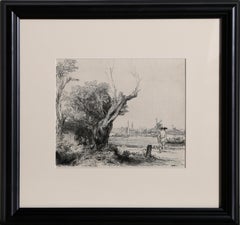Items Similar to 17th century etching black and white figurative character print expressive
Want more images or videos?
Request additional images or videos from the seller
1 of 9
Jan Gillisz van Vliet17th century etching black and white figurative character print expressive1650
1650
$1,620
£1,255.81
€1,421.48
CA$2,318.57
A$2,530.07
CHF 1,313.26
MX$30,270.15
NOK 16,669.41
SEK 15,614.02
DKK 10,617.99
About the Item
Jan Gillisz van Vliet (1605–1668) was a Dutch Golden Age artist and student of Rembrandt. He worked with Rembrandt between 1628 and 1637, inspired by his master's work. Like Rembrandt, van Vliet made a series of beggar figures, though often with a greater degree of satire and expressiveness. For example, this image of a rat catcher from 1632 is directly related to Rembrandt's "The rat-poison peddler" of the same year, though van Vliet has infused it with humor: the peddler is shown arguing with the rats who are supposedly eating poison at his tray.
3.63 x 2.38 inches, print
13.5 x 20.25 inches, frame
Faint signature "JG Vliet fec" in plate, upper left
Framed to conservation standards using archival materials including 100 percent rag matting; housed in a white gold finish wood moulding.
Overall good condition; some planar distortion in corners of prints; tear in upper right corner; frame in good condition with some wear to silver surface.
- Creator:Jan Gillisz van Vliet (1628 - 1669, Dutch)
- Creation Year:1650
- Dimensions:Height: 16.75 in (42.55 cm)Width: 15.38 in (39.07 cm)
- Medium:
- Movement & Style:
- Period:1630-1639
- Condition:Overall good condition; some planar distortion in corners of prints; tear in upper right corner; frame in good condition with some wear to silver surface.
- Gallery Location:Milwaukee, WI
- Reference Number:Seller: 9771g1stDibs: LU60536529902
About the Seller
4.9
Gold Seller
Premium sellers maintaining a 4.3+ rating and 24-hour response times
Established in 1966
1stDibs seller since 2017
452 sales on 1stDibs
Typical response time: 1 hour
- ShippingRetrieving quote...Shipping from: Milwaukee, WI
- Return Policy
More From This Seller
View All18th century triptych etching figurative prints small black and white expressive
By Francois Vivares
Located in Milwaukee, WI
François Vivares was known to have produced several copies of images after older masters, such as, in this case, Rembrandt van Rijn. In this set, Vivares reproduces "The Quacksalver" (1635, Bartsch 129), "Beggar man and beggar woman conversing" (1630, Bartsch 164), and "Beggar Seated Warming...
Category
1760s Old Masters Figurative Prints
Materials
Etching
17th century etching black and white figures scene
By Cornelis Bega
Located in Milwaukee, WI
"The Singer" is an original etching by Cornelis-Pietersz Bega. It depicts a performer and onlookers. Publisher: Pearce #50.
4" x 3" art
16 1/2" x 13 1/2" frame
Cornelis Pietersz Be...
Category
Mid-17th Century Old Masters Figurative Prints
Materials
Etching
17th century etching black and white indoor dramatic figures scene
By Cornelis Bega
Located in Milwaukee, WI
"The Meeting" is an original etching by Cornelis-Pietersz Bega. It depicts a confrontation between two groups of figures. Publisher: Pearce #48.
2 3/4" x 2 3/4" art
10 1/4" x 10 3/8...
Category
Mid-17th Century Old Masters Figurative Prints
Materials
Etching
'Portrait of Henrico van der Borcht, ' original W. Hollar engraving after Holbei
By Wenceslaus Hollar
Located in Milwaukee, WI
In this print, Wenceslaus Hollar presents a portrait of D. Henrico van der Borcht, copying a painting or drawing by Hans Holbein. Copying works of famous masters was a common task of...
Category
17th Century Old Masters Portrait Prints
Materials
Engraving
'The Smoker (Le Fumeur)' original etching by Cornelis-Pietersz Bega
By Cornelis Bega
Located in Milwaukee, WI
'The Smoker (Le Fumeur)' is an original etching by the celebrated Dutch painter and printmaker Cornelis-Pietersz Bega. It presents a genre scene of the type Bega was best known for: Bega's principal subjects were genre representations of taverns, domestic interiors and villages. He depicted nursing mothers, prostitutes, drunks, gamblers and fools such as quack doctors and alchemists. In this case, he shows a man seated on a chair with his foot on a flat stool and holding a smoking pipe. For Bega, this representation was more of a caricature than it was an image of a specific person, and such genre scenes would have held allegorical and symbolic meaning for the seventeenth-century viewer. During the seventeenth century, the Dutch of all levels of society consumed tobacco and alcohol, and these were an important part of the Dutch economy and a major source of wealth. At the same time, however, moralists and ministers sought to curb intoxication: they openly described drinking and smoking as sinful, immoral, and a general threat to one’s reputation. This paradox is reflected in prints such as this, which inherently carry the national pride of the Dutch economy alongside a moral warning in a print that could be just as easily consumed and collected.
2.5 x 2.25 inches, print
12.38 x 10.38 inches, frame
Framed to conservation standards using archival materials including 100 percent rag matting and mounting materials. Housed in a gold finish Spanish-style wood moulding.
Overall good and stable condition; margins cut to plate; some wrinkling in the corners from previous mounting; housed in a new custom frame.
Cornelis Bega was born into prosperous circumstances. His mother, Maria Cornelis, inherited half the estate (gold, silver, paintings, drawings and prints) and all of the red chalk drawings of her father, Cornelis Cornelisz van Haarlem, a renowned Mannerist artist. Bega's father was Pieter Jansz Begijn (d 1648), a gold and silversmith.
Like other family members, Bega was probably Catholic. Houbraken's claim that Bega studied with Adriaen van Ostade is likely to be correct; this was probably before 24 April 1653, when Bega joined Vincent Laurentsz. van der Vinne in Frankfurt for a journey through Germany, Switzerland and France. Bega had returned to Haarlem by 1 September 1654, at which time he joined the Guild of St Luke; he was already a competent draughtsman, as indicated by his first extant dated work, Interior with a Nursing Mother (1652; Frankfurt am Main, Städel. Kstinst.), and by a remarkable double portrait (Amsterdam, Rijksmuseum) drawn by him and Leendert van der Cooghen in 1654.
Bega painted, drew, etched and made counterproofs in a wide variety of materials on different types of small-scale supports. He may have been the first Dutch artist to make monotypes, but this remains controversial. Approximately 160 paintings, 80 drawings and six monotypes by Bega have been catalogued, as well as around 34 etchings.
Bega's principal subjects were genre representations of taverns, domestic interiors and villages. He depicted nursing mothers, prostitutes, drunks, smokers, gamblers and fools such as quack doctors and alchemists. Less common subjects include the ridiculed or pestered woman, as in Two Figures and Mother with a Spirits Bottle (c. 1662; Gouda, Stedel, Museum Catharina Gasthuis) and The Inn (etching), as well as witty satires on traditional scenes of middle-class music-makers, such as the Music Lesson (1663; Paris, Petit Palace).
Bega's early paintings, such as the Weaver's Family (c. 1652; St Petersburg, Hermitage), are freely executed, dark and coarse, recalling the many-figured peasant subjects of van Ostade. Between c. 1660 and 1664 he began to paint genre scenes with fewer figures, which are finely articulated, colourful and psychologically expressive, for example Two Men Singing (1662; Dublin, N.G.). His exquisite, late fijnschilderen ('fine painting') manner, evident in The Alchemist (1663; Malibu, Getty Museum), compares well with that of Gerrit Dou.
As a draughtsman Bega is noted for his single-figure studies, executed mainly in black and white chalk on blue paper or red chalk on white paper. None of the studies, which were drawn naer het leven (from life), seem to relate to a painting or etching. Bega traded drawings or shared models with other artists of the Haarlem school, including van der Cooghen, Gerrit Berckheyde, Dirck Helmbreker and Cornelis Visscher. These artists drew chalk figure studies in a very similar style, characterised by regular and precise parallel shading and well-defined forms; their drawings, especially those of Bega and Berckheyde, have been frequently confused. Unlike the realistic figure studies, Bega's etchings depict interiors with figures or single figures in the manner of van Ostade; the compositions, often with masterful chiaroscuro effects, reflect most closely the paintings of the 1650s.
Bega is likely to have remained in Haarlem, where he paid dues to the Guild in 1661. He probably died from the plague; fees for his expensive funeral at St. Bavo's were paid on 30 August 1664. Among the artists he influenced were Thomas Wijck, Jan Steen, Richard Brakenburg (1650-1702) and Cornelis Dusart. Painters such as R. Oostrzaen ( fl ?1656) and Jacob Toorenvliet...
Category
17th Century Old Masters Figurative Prints
Materials
Paper, Etching
17th century etching Rembrandt landscape house trees field sky cow
By Rembrandt van Rijn
Located in Milwaukee, WI
This piece is from a collection of originally designed etchings with drypoints by Rembrandt. It is printed on Ingres D'arches off-white laid paper. The prints are the sixth and final state Posthumous Impression. Printing plates were made in 1650, this collection was printed in 1998.
Rembrandt van Rijn was one of the masters of the landscape genre in his prints and drawings. In his etching, "Landscape with a Cow...
Category
17th Century Renaissance Landscape Prints
Materials
Etching
$7,540 Sale Price
20% Off
You May Also Like
Giovanni Benedetto Castiglione, 1609-1664, Young Man, Etching Circa 1640
By Giovanni Benedetto Castiglione
Located in Toronto, CA
This is an original etching by Giovanni Benedetto Castiglione, circa 1640, of a Young Man Looking Down to the Right. It is the only known state and belongs to the series known as 'Studies of Heads in Oriental Headdress'. Signed (in monogram) in the plate in the upper right 'G Castiglione Genovese.'
In a delicate gilt/black frame. Frame dimensions 12.75" by 8.75". Certificate of Authenticity.
In this work, Castiglione offers us an exquisite portrait of a young man. This small etching shows all the hallmarks of Castiglione's style: incredibly detailed etching marks that result in a wonderful play of light and shadow. The angle of the head and the lively floating feather in the young man's hat show us a figure in movement, pausing to look at something the viewer can only guess at. That such a small collection lines and cross-hatchings can evoke so much is a testament to Castiglione's genius.
Giovanni Benedetto Castiglione was an Italian Baroque painter, printmaker and draftsman of the Genoese school. He is best known now for his etchings, and as the inventor of the printmaking technique of monotyping. He was known as Il Grechetto in Italy and in France as Le Benédette.
Castiglione was a brilliant draftsman and pioneered the development of the oil sketch (often using a mixture of mediums) as a finished work.
He is credited with having invented the monotype in 1648, the only printmaking technique to be an Italian invention, making over twenty over the succeeding years. His most popular and influential prints were a series of exotic heads, mostly of vaguely Oriental males, but also of women.
From Bartch/Bellini:
Giovanni Benedetto Castiglione was profoundly influenced by foreigners. He first studied with local artists in his native Genoa, absorbing not only Tuscan Mannerism and Caravaggism but also the style of Peter Paul Rubens, who had worked in Genoa. From 1621, Castiglione also worked in Anthony van Dyck's Genoa studio. Early on, he was attracted to Flemish animal painting. Though he painted portraits, historical pieces and landscapes, Castiglione excelled in rural scenes with animals and influenced Italy's animal painting specialists. By 1634, Castiglione was in Rome, where he remained for about ten years. After returning to Genoa for a time, he worked for the Mantuan court in 1648, which had also employed Rubens. There Castiglione picked up the freedom of touch he saw in Domenico Fetti's paintings. One of the first Italians to appreciate Rembrandt van...
Category
Antique 17th Century Italian Baroque Prints
Materials
Paper
Les Gueux, Baroque Etching by Jacques Callot
By Jacques Callot
Located in Long Island City, NY
Jacques Callot, French (1592 - 1635) - Les Gueux, Medium: 2 Etchings on paper from Les Gueux suite appelee aussi Les Mendiants, Image Size: 5.5 x 3.5 inches, Size: 7.5 x 11 in. (19.0...
Category
Early 17th Century Baroque Prints and Multiples
Materials
Etching
Fine 17th Century Italian Etching by Salvator Rosa, 1615-1673
By Salvator Rosa
Located in Vero Beach, FL
Salvator Rosa, the Italian Baroque painter was also a significant etcher and printmaker. Rosa’s is series of small prints of soldiers was very popular and influential. This etching i...
Category
Antique 17th Century Italian Baroque Prints
Materials
Paper
$630 Sale Price
40% Off
Vue d'Omval pres d'Amsterdam (B209), Heliogravure by Rembrandt van Rijn
By Rembrandt van Rijn
Located in Long Island City, NY
Rembrandt van Rijn, After by Amand Durand, Dutch (1606 - 1669) - Vue d'Omval pres d'Amsterdam (B209). Year: 1878 (of original 1645), Medium: Heliogravure, Size: 7.5 x 9 in. (19.05 ...
Category
Late 19th Century Baroque Prints and Multiples
Materials
Etching
Pasquariello Truonno, Meo Squaquara
By Jacques Callot
Located in San Francisco, CA
Artist: Jacques Callot (French, 1592-1635)
Title: Pasquariello Truonno, Meo Squaquara
Year: 1622
Medium: Etching
Paper: Laid paper
Size of paper: 2.35 x 3.95 inches
Condition: Very g...
Category
17th Century Realist Figurative Prints
Materials
Etching
Italian 17th Century Etching after Federico Barocci 1535-1612.
Located in Vero Beach, FL
Italian 17th Century Etching after Federico Barocci 1535-1612.
This is Barocci’s rare image of, “Women wrapped in cloths”, page 79 and probably from a folio. The logo “Studio Vigila...
Category
Antique 17th Century Italian Renaissance Prints
Materials
Glass, Paper
More Ways To Browse
Antique Character
Antique Rat
Antique Poison
Ryan Hewett
S L Margolies
Salvador Dali Bull
Salvador Dali Fallen Angel
Salvador Dali Fashion Designer
Salvador Dali Hamlet
Salvador Dali Jesus On The Cross
Salvador Dali Judah
Salvador Dali Paradise 6
Salvador Dali Paradise Lost
Salvador Dali Purgatory 1
Salvador Dali Self Portrait
Salvador Dali Signature
Salvador Dali Signed Paradise
Salvador Dali Signed Purgatory Canto
